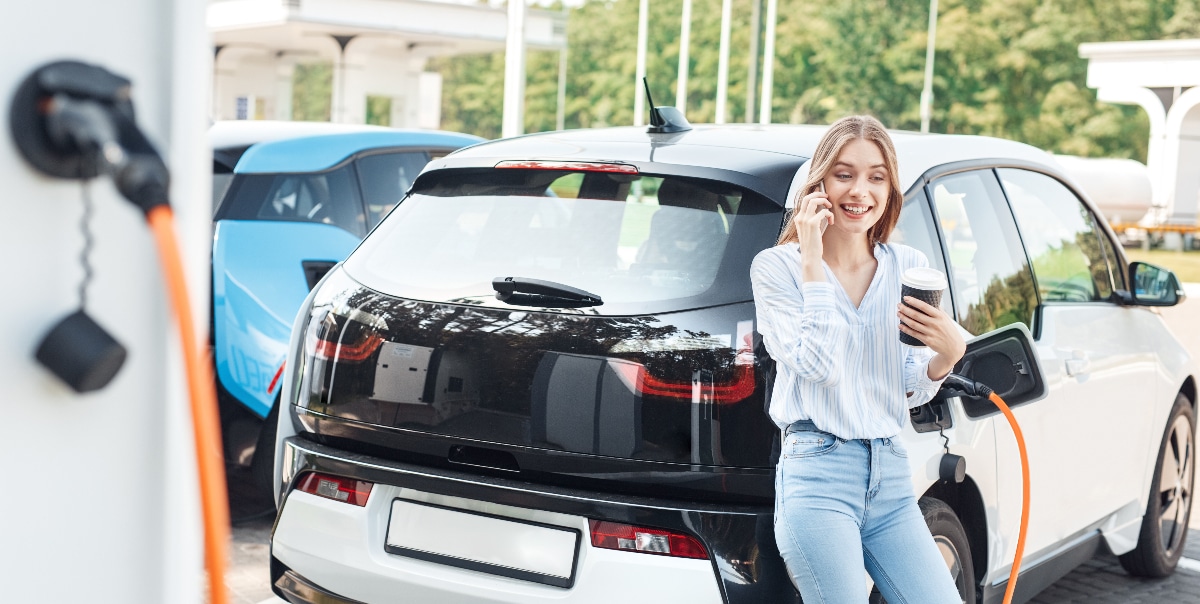How long does it take to charge an electric car at a public charging station?

5 Min. Read
Media attention on government plans to build an infrastructure to support electric vehicles (EVs) on U.S. highways may have heightened range anxiety in those considering EVs.
However, support for electric cars already exists in many parts of the country, where more EVs can be seen on the roadways every month.
Read on to learn more about on how long it takes to charge an electric car at public charging stations and the availability of chargers.
EV charging 101
In many ways, charging your EV is a lot like charging your phone. Ideally, you develop a habit of plugging in your car at night, just like your phone, and maybe charging while you work too. Many people carry a phone charger to plug in wherever they can. The same is somewhat true with an electric vehicle.
The big difference between charging your phone and your vehicle is that it can take a long time to fully charge an electric car using the plug it came with. Luckily, there are faster chargers available in public settings that can give you more range or a complete charge in about an hour.
Here are the three types of EV chargers:
- Level 1. The charger included with most new EVs is a Level 1. Their advantage is the ability to plug your vehicle into any standard 120-volt outlet. It is an asset to keep on in the trunk … just in case. However, a Level 1 charger plugged in all night will only add another 50 miles of driving range for many EVs. That works great for most commuters, but not long trips.
- Level 2. These chargers, which require a 240-volt outlet, are the most common in public settings and up to 10 times as fast as Level 1 chargers. A one-hour stop at a shopping center with Level 2 public chargers will usually give you another 28 miles of range. Even though installing Level 2 chargers at home may require upgrading your electric panel or circuits, they can charge a 124 to 300 mile drive range in about five hours depending on the capacity of the charger.
- Level 3. These DC fast chargers are still harder to find and using them costs more. But Level 3s can produce a full charge within an hour or 100 miles of range in a half hour. Not all EVs can use these chargers, so it is important to know what the vehicle can use.
Connectors Differ Too
Most automakers around the world are manufacturing EVs. However, just like differences in electrical plugs required in different parts of the world, the automakers use different types of EV connectorsto charge an electric car.
Don’t worry, you have these adapters to choose from:
- L2 – J1772.This connector (also known as a “J Plug”) is typically used on slower chargers at home or work for all electric cars except Tesla, which has an adapter for owners to use.
- CHAdeMO (or Charge de Move). This adapter is a standard in some countries, particularly Japan. Accordingly, Mitsubishi, Nissan and Toyota use it.
- Combined Charging System or CCS connector. This connector type is used worldwide by various electric auto makers. In North America, however, it is now the standard for newly manufactured electric passenger cars, except Tesla.
- Jumping on the fast-charge bandwagon before others, Tesla developed their own connectors and chargers. Telsa sells adaptors so its customers can use other fast charge stations too.
Factors that affect charging time
Much like miles per gallon can vary, an electric vehicle’s driving range per charge can also vary based on driving experience. Things that can affect your range include driving too fast, riding the brakes, heavy use of the air conditioning or heater, and climbing mountains.
While driving affects the mileage you get per full charge, there are other factors that affect the time required to charge an electric car:
- Weather conditions.Batteries do not like weather that is too hot or too cold. Warm weather can affect efficiency and colder temperatures can slow charging time.
- Type of car and battery size. Car models and battery sizes can have different results depending on the EV model. Putting eight gallons of gas in one car will not take more time than fueling another car. With EVs, however, fueling is different between makes and models.
- The car’s maximum charging rate . An EV has a maximum rate of charge, so some cannot accommodate the power of a Level 3 charger. For those cars, a fast charge is not possible.
- State of charge (SOC) level. Batteries charge fastest when they are nearly empty. An EV slows its charge rate once it reaches 80% full as a precaution. So, filling the remaining 20% with a Level 3 charger does not make sense. It will cost more and not fill at a Level 3 rate.
Another factor that affects charging time is charger availability. Most shopping centers, office buildings, hotels and tourist destinations are putting in charge stations. Additionally, new companies are building networks of charging stations throughout the U.S. and Canada. These include EVGo, ChargeHub, PlugShare, Chargepoint, Electrify America and Electrify Canada.
Most charging networks feature smartphone apps to help you locate charging stations near you. The apps tell you the types of chargers and connectors on site and charger availability. This helps ensure you can find a charger long before you are running low on power.
Where is most charging done?
One of the most important facts to know about charging an EV is that 80% of charging is done at home, generally overnight, or while the vehicle is parked at work. Installing a charger that operates faster than Level 1 makes this possible for most.
How do you find qualified, experienced contractors to install a higher level EV charger? Call Qmerit!
An industry leader, many EV makers recommend Qmerit’s turnkey installation services. Qmerit works with homeowners, automakers, fleet managers and others to implement the competitively priced EV charging solutions.
Spread across the U.S. and Canada, Qmerit’s certified network of technicians are thoroughly vetted, trained and use the highest safety and quality standards.
To find out more about our highly rated installation services, contact Qmerit today.
